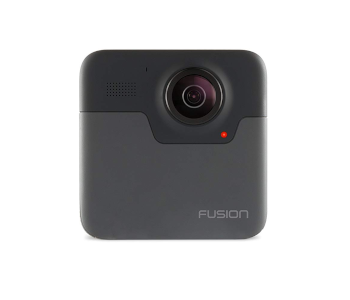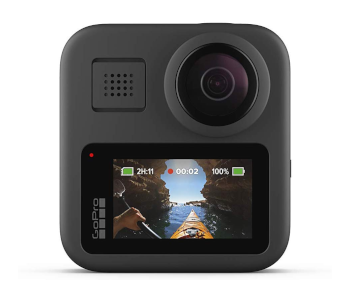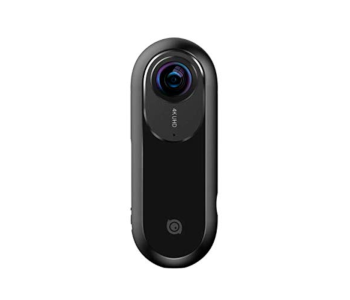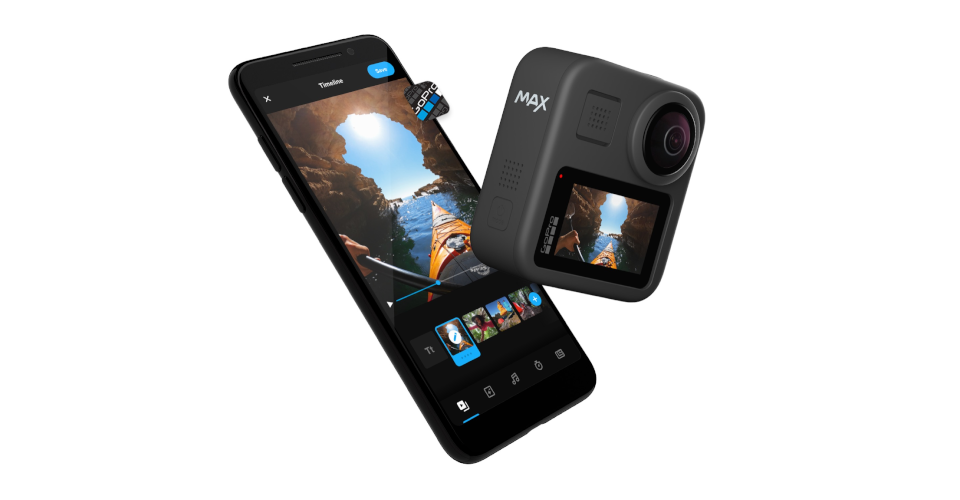GoPro Max vs. GoPro Fusion vs. Insta360 OneX
360 cameras are a bit of a strange piece of technology in that if you’ve never needed one, then you’re unlikely to develop any sort of interest for them. Despite this, the competition in the 360 camera market has been heating up in the last couple of years with a big brand like GoPro entering the fray.
In this article, we compare three of the most popular 360 cameras available today: the Fusion and Max, both from GoPro, and the OneX from Insta360. GoPro has built a solid reputation on the back of their action cameras and have only recently ventured in 360 camera technology. In contrast, Insta360 is a relatively young company that has focused only on 360 cameras since their inception. Will the old reliable win, or will the scrappy new entrant topple them over?
Overview

The Fusion, launched way back in November 2017, was GoPro’s first foray into the 360 camera market. By offering a 360 camera with the same rugged build as their action cameras, GoPro was able to come up with a product offered something distinct from all other alternatives in a market that was already starting to get crowded. At a launch price of $599, the GoPro Fusion wasn’t exactly cheap, and it was not without criticism. An overly complex workflow and poorly implemented mobile app were among some of the major areas of improvement of GoPro’s maiden 360 camera.
In October 2019, GoPro released the second entry in their 360 camera lineup: the
GoPro Max. Smaller and lighter than the Fusion, the GoPro Max featured a touchscreen interface, more camera modes, and a more streamlined workflow. The Max even launched with a lower $499 price tag, although the Fusion has dropped in price by a fair lot by this time.
Founded in 2014, China-based Insta360 has mostly focused on prosumer-grade, smartphone-based 360 cameras but has, more recently, branched out to steady cams and professional VR camera rigs. The
OneX, launched in October 2018, is their first handheld standalone 360 camera and has a design geared towards giving it more rugged features.
With six-axis digital stabilization and an optional waterproof camera, the OneX is a capable adversary to GoPro’s line of rugged 360 cameras. Better yet, the Insta360 OneX had a launch price of $399 – lower than any of the GoPro alternatives.
Build and design
| Parameter | GoPro Fusion | GoPro Max | Insta360 OneX |
|---|---|---|---|
| Weight | 220 grams | 154 grams | 115 grams |
| Size | 74 x 75 x 40 mm | 64 x 69 x 24 mm | 114.5 x 48 x 27.6 mm |
A side-by-side comparison makes it clear that the GoPro Fusion is easily the largest and heaviest of the three. In fact, the bulky design of the GoPro Fusion makes it one of the largest 360 cameras released in recent years. The size of the battery of the Fusion and the provision for two microSD cards certainly play a role in increasing its overall bulk. It’s still a pretty compact camera, but mounting it is going to be more difficult than a standard action camera.
The GoPro Max features a more compact and blocky design reminiscent of GoPro Hero action cameras. Its short and stout build makes the GoPro Max the perfect 360 camera for action cam-style mounting. Like any GoPro camera, the Max comes with the standard GoPro three-pronged mount that makes it compatible with a whole ecosystem of accessories.
The design of the Insta360 OneX went on a bold new direction in an apparent bid to make it look as different from the GoPro as possible. However, this may have been a misstep for the Insta360, especially as they have billed the OneX as a possible action camera. The OneX is even lighter than the GoPro Max but has a narrow and long form factor. Mounted on a bike helmet or a surfboard, this just makes the OneX jut out by about 5 inches and makes it even more prone to vibration.
Where the OneX excels is in handheld use. The OneX handles just like a smartphone, and the control buttons can be easily accessed by your thumb if you cradle the camera in your hand. With its long and narrow design, it’s so much easier to make sure that your hand and fingers don’t become unintentionally included in all of your shots.
Both the GoPro Max and the Insta360 OneX have unique characteristics that make them suited for different uses, so we’re calling it even.
GoPro Max +1
Insta360 OneX +1
Durability
GoPro has built a reputation founded on how tough and rugged their action cameras are, and it’s no surprise that they have brought this level of superior design to both the Fusion and Max 360 cameras. Both cameras are waterproof up to 5 atm of water pressure, corresponding to a depth of about 16 feet. They also come with a shock-resistant casing, although the Fusion ramps up the shock proofing factor a bit with its rubber-lined body.
The Insta360 OneX has been billed to be tough enough to be used as a camera, but it’s not waterproof on its own. Instead, you’ll need to get an accessory such as the OneX Dive Case, which is rated to an impressive depth of 30 meters. The OneX is also not shockproof, so we’re not entirely sure if it’s a good idea to use this 360 camera to document your rough hike or your paddling trip through some whitewater.
GoPro Fusion +1
GoPro Max +1
User interface

Whether by deliberate design choice or by the limitations of technology, the GoPro Fusion has a physical interface that keeps things simple. It features the signature GoPro-style front-facing LCD screen that displays basic info like the remaining battery, the storage space left in the SD card, and which camera mode is activated. Scrolling through the various modes and settings is done through a basic two-button interface.
While old GoPro users will feel right at home with this simple user interface, it just takes too long to get anything done when you’re only given two buttons. The GoPro Max addresses this problem by integrating a 1.7-inch full-color touchscreen – the same one that can be found in later GoPro Hero action cameras.
Aside from making it much easier to adjust settings and toggle the various camera modes, the touchscreen also serves as a display for either of the two cameras. With this handy live preview tool, composing and framing shots can be done in the GoPro Max, even without using the mobile app. It also allows you to check shots immediately after taking them without having to go through the time-consuming step of transferring them to your phone.
In terms of the physical user interface, the Insta360 OneX is more similar to the Fusion than the Max. It does have a touchscreen but instead makes do with a simple circular LCD screen that displays the current camera mode plus other basic data. It also only has two buttons that serve all the necessary functions, including scrolling through the various settings, taking quick stills, and start recording videos. The same limitations that apply to the GoPro Fusion can be said here. While the two-button interface works, it definitely feels outdated.
GoPro Max +1
Video and photo quality
| Parameter | GoPro Fusion | GoPro Max | Insta360 OneX |
|---|---|---|---|
| 360 videos | 5.6K @ 30 fps | 5.6K @ 30 fps | 5.7K @ 30 fps |
| Flat videos | No capability | 1440p @ 30 fps | No capability |
| Stills | 18 MP (RAW) | 16.6 MP | 18 MP (RAW) |
In terms of the physical sensor in the cameras of all three models, there does not seem to be any significant difference. In terms of raw resolution, the OneX holds the slight advantage – 5.7K against the 5.6K of the Fusion and the Max. In any case, all three fall to the drawback that is common to all 360 cameras, namely that the pixels get stretched over a wider field of view. Thus, you cannot expect a 360 video with a 5.7K resolution to look as good as a flat video with a similar resolution.
The GoPro Max has been marketed as being three cameras in one: a 360 camera, a Hero-like action camera, and a vlogging camera. This highlights one of the distinct advantages of the Max: the ability to switch between 360 videos and flat videos. Better yet, you can choose to capture flat videos using either the front or back-facing cameras. There’s a lot of cropping involved, though, so the Max can only capture flat videos at 1080p.
Matters are seemingly reversed when it comes to capturing stills. While all three cameras have similarly sized sensors, the GoPro Fusion and the Insta360 OneX can capture stills up to 18MP because of their ability to shoot photos in RAW format. Professional photographers may prefer the post-processing and color grading freedom that they can get with such a feature, although it comes at the price of larger file sizes.
Underneath the hood, the GoPro Max supports H.265 (HEVC) encoding using the GP1 processor, which is the same one found in later models of the GoPro Hero Black. The upgraded coded is more efficient than those found in the GoPro Fusion and Insta360 OneX, resulting in smaller file sizes. This is also the reason why the Max only requires one microSD card, in contrast to the two slots found in the GoPro Fusion.
Each of the three models has a few tricks up its sleeves, but we’ll get to those later. In terms of raw power and resolution, it looks like a toss-up between all three.
Stabilization
| Parameter | GoPro Fusion | GoPro Max | Insta360 OneX |
|---|---|---|---|
| Stabilization tech. | Fusion stabilization | Hypersmooth 2.0 | Flowstate |
Stabilization is a very important feature for any handheld camera, especially if it‘s meant to be mounted on a moving object. Each one of the three cameras featured here come with their own gyro-aided six-axis stabilization algorithm. Each one also comes with a fancy name.
In a nutshell, the stabilization performance of all three models are virtually similar. They all pretty much take the same approach to stabilization: by recoding 360-degree videos and reframing the footage to smooth out any vibrations. Whichever model you choose to go with, you can expect to create perfectly smooth videos with it.
Audio
| Parameter | GoPro Fusion | GoPro Max | Insta360 OneX |
|---|---|---|---|
| Microphones | 1 on front, 3 on top | 6 internal microphones | 2 internal microphones |
Audio recording has always been a weak point for any handheld camera. Internal microphones typically do a poor job of recording spatial audio and are highly prone to noise. The three cameras featured here are no exception. While there’s a clearly superior choice, none of the options can offer the quality of audio recording that an external shotgun mic can produce.
GoPro has made an effort to simulate spatial audio as much as possible in both the Fusion and the Max. The assembly of microphones in the Fusion provides some depth to the sound it records, although it’s still limited to a single plane.
With the GoPro Max, this limitation is no longer an issue. The 6-microphone assembly records 360-degree audio, adding an extra dimension of immersion to your 360 videos. Whether you’re using the Max for vlogging or to document your adventures, its audio capability will surely come in handy to take your videos to the next level.
Of course, not even the best internal microphone setup can cancel out the noise from strong winds. Unfortunately, you don’t have much of a choice with these 360 cameras. None of them have an input port for an external microphone, unlike true action cameras like the GoPro Hero Black 8.
GoPro Max +1
Software and workflow

An inefficient workflow that resulted in tedious post-processing was one of the major criticisms with the GoPro Fusion back when it was first launched. Its companion mobile app run into a lot of problems with connectivity, and its editing functions were heavily limited. Although the desktop editing software for the Fusion was much more useful, transferring files from the camera to a PC took much longer than expected.
Although the workflow for the Fusion was drastically improved by upgrades that GoPro rolled out over the years following the initial launch, the initial impressions certainly affected how the product was perceived by the market.
To GoPro’s credit, they seem to have listened to all the criticism and made the necessary steps to solve all of these issues with the GoPro Max. The companion mobile app for the Max is much more robust in terms of maintaining connectivity. The best upgrade is the ability to reframe your 360 videos straight from the mobile app. This means that you no longer need to spend a lot of time transferring files from your camera to a PC and editing them on the desktop software.
The implementation of the same feature on the Insta360 mobile app is less intuitive, but all the same capabilities are there. You can either set a Pivot Point where the camera will keep its focus or a SmartTrack, which the camera will follow as the perspective moves around. The fact that you can do such advanced edits on a smartphone and instantly upload your clips to social media is extremely impressive.
The implementation of editing through the Insta360 mobile app may be a little rough around the edges, but we’ll still call a toss-up between the GoPro Max and the OneX.
GoPro Max +1
Insta360 OneX +1
Battery
| Parameter | GoPro Fusion | GoPro Max | Insta360 OneX |
|---|---|---|---|
| Battery capacity | 2620 mAh | 1600 mAh | 1050 mAh |
| Total recording time | 75 minutes | 75 minutes | 60 minutes |
The major reason for why the GoPro Fusion was so large and heavy was its battery. At the time, the 2620-mAh battery was necessary to power the Fusion for up to 75 minutes of video recording. By using a more efficient processor and codec, the GoPro Max was able to retain the same total recording time but with a much lighter and smaller battery.
The Insta360 OneX, on the other hand, seemed perfectly fine with compromising a little on recording time for the sake of keeping the footprint of the camera as small as possible. While the extra portability is a welcome feature, we’ll have to give this category to the two GoPro cameras.
GoPro Fusion +1
GoPro Max +1
Other features
Lastly, let’s look at some of the more unique features of each 360 camera.
When the GoPro Fusion was launched, it proudly came with the oft-touted OverCapture mode. While this mode was activated, the camera recorded a full 360-degree video of its surroundings. In theory, this should allow you to compose your shots in virtually endless ways during post-processing.
The problem with the Fusion’s OverCapture mode was in the execution. As we’ve already mentioned, transferring the files from the camera to a PC for editing in Fusion Studio took much longer than expected. Once the files are on deck, you’ll discover that the editing options are quite limited. You can’t actually compose your shots to have smooth pans and zooms – the software only allowed you to pick a fixed angle and stick with it.
The OverCapture mode returned with the GoPro Max, but it was now called “Reframe.” The Reframe mode delivered on the promise of OverCapture – the ability to edit and create clips directly from the mobile app. If you’re not eager to put in the hours tweaking around with your footage on professional video editing software, then the Reframe feature should be exactly what you’re looking for.
We’ve already mentioned how the GoPro Max has a “Hero Mode” for simulating an action camera, but another thing that’s unique with this camera is the Powerpano feature. In Powerpano mode, the GoPro Max creates a 270-degree extra-wide panorama that covers just about everything in its environment save for the person taking the photo.
To wrap it all up, the GoPro Max can livestream video to social media channels if you have an active Internet connection, although the resolution is limited to only 1080p.
The Insta360 OneX, despite the modest cost and size, actually packs a punch in the features department. It also has a variant of the Reframe feature which allows you to edit 360 video clips on the fly, although the interface of the mobile app could use some improvement. It also has a livestreaming function which raises the bar set by the GoPro Max by streaming videos at 4K resolution.
The OneX still has an ace up its sleeve – a couple of features that make it the superior choice for capturing a better profile in stills and videos. This 360 camera offers a log gamma color profile, which maintains a more dynamic range and more color grading options. On the video front, an HDR (high dynamic range) mode is also offered. The improvements in photo and video quality using these modes are quite noticeable, with a bit less compression and less sharpening.
With a host of features that aid in both video editing and modifying the quality of clips and stills, this round goes to the Instra360 OneX. The Max still holds the advantage over the Fusion.
GoPro Max +1
Insta360 OneX +2
Price
Almost two years since its launch, the GoPro Fusion has the distinct advantage of a current selling price that is much lower than the price it went for originally. The GoPro Max and the Insta360 OneX are still pretty new, so you might not find them at discounted prices yet. Even at their launch price tags, the Max is still $100 more expensive than the OneX, and we’ll have to take that into account.
GoPro Fusion +2
Insta360 OneX +1
Final verdict
| GoPro Fusion | GoPro Max | Insta360 OneX |
|---|---|---|
| 4 | 7 | 5 |
Based on our final tally, the GoPro Max comes ahead of the pack with a pretty convincing lead. It’s the perfect all-around package: small, lightweight, rugged, comes with an improved mobile app, and can record more than an hour’s worth of video in one battery cycle. The fact that you can use the Max like a standard action camera is the cherry on top of a cleverly designed 360 camera, which we expect to be the new standard for the 360 camera industry as it moves forward.
The Insta360 OneX puts up a good fight. It can even be argued that it’s a more suitable option for specific applications. With its ability to shoot photos in RAW mode, HDR mode, and a log gamma color profile, there are so many more post-processing options that you can play around with when using the OneX. Its form factor doesn’t lend well to action cam-type mounting, but we’re sure that you can make it work somehow if absolutely needed.
The GoPro Fusion isn’t exactly a bad purchase since it’s now so cheap and is still a solid 360 camera. There are a lot of things that it does well, such as excellent stabilization in a sufficiently rugged build. It’s just that the GoPro Max is almost across the board a better option. If you’re looking for something cheap, then the GoPro Fusion is as good a 360 camera as any that you can get at this price range. But if you can afford to save up a bit more, either the Insta360 OneX or the GoPro Max offers a more future-proof option.

